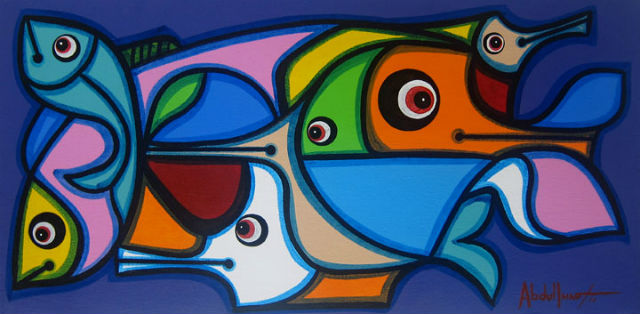Filtered by: Cbb
Community Bulletin Board
Abdulmari Imao presents Mythical Realms in celebration of his 77th birthday
Dr. Abdulmari Imao (Conferred the Order of National Artist for Sculpture, 2006) is perhaps the most “Asian” of the Philippine National Artists. Born and raised in Sulu, he celebrates his Mindanaon heritage by drawing inspiration from Tausug and Maranaw art and lore and from the richness of Southeast Asian culture and mythological traditions. With his consistent and successful usage of folk themes, myths and legends, his work strongly links Filipino, Malay and Indonesian cultures. They go beyond the clichéd appropriation of genre scenes so common in Philippine art. Imao creates and assumes, both with his sculptures and paintings, Southeast Asian archetypes to retell the myths and legends of the culture of his birth.

His works featuring the sari-fish acknowledge that he was once a fisherman.
With his consistent and successful usage of folk themes, his most familiar motif, for example, that of the sarimanok is essentially a link to that story of a rooster in the first of seven heavens. Aside from the belief that it brings good luck, the sarimanok , a bird whose vibrantly colored tail is believed to have been dipped in the rainbow, is alternately said to be a messenger of the gods or the mythical lover of a datu’s beautiful daughter. That same motif persists in different Southeast Asian cultures—the serpent naga of Malaysia, the most evident example. These regional thematic linkages set the practice of Imao apart in the Philippine art community as something truly unique. It isn’t surprising then that Imao’s art represents a visual rendering of the Philippines’ place within the community of Southeast Asian art and characterizes an important aspect of the national artistic trajectory.
On the occasion of the National Artist’s 77th birthday, Galerie Joaquin examines Imao’s navigation through national and regional mythologies in an exhibition of his latest works. Entitled Mythical Realms, the exhibition is a fascinating survey of the intellectual nous and technical intricacies that have seen Imao become an important figurehead in Philippine visual art. The show opens on January 31 at Galerie Joaquin’s main gallery in San Juan and runs until February 14, 2013. Mythical Realms displays the best examples culled from the prolific oeuvre of this living national treasure.
The exhibition looks into three of Imao’s most iconic design themes: sarimanok, the sari fish and calligraphy which is his homage to a greater deity.
The exhibition looks into three of Imao’s most iconic design themes: sarimanok, the sari fish and calligraphy which is his homage to a greater deity. Taking two forms, acrylic on canvas and brass/wood sculptures, he revels in a bold use of bright colors, bold lines, and an abstract, stained glass window-like aesthetic sensibility. His works prominently feature the ukkil or okir – geometric flowing designs used to decorate southern traditional clothing, weapons and houses. The brilliance is that he applies the same aesthetic styles to all forms—so one can look at a sarimanok brass figure and think that it jumped out of a sarimanok canvas. His works featuring the sari-fish acknowledge that he was once a fisherman. Inspired by the colorful fishes of the Sulu Sea, he lets his imagination run rampant with the vivid colors that he uses in his paintings.
This immense technical and conceptual aptitude is a hallmark of the National Artist. Graduating from the College of Fine Arts at the University of the Philippines, his teachers have included National Artists Guillermo Tolentino and Napoleon Abueva, while he is the contemporary of the likes of National Artist Jose Joya. As a Smith Mundt and Fulbright Scholar, he received a Master of Fine Arts degree from the University of Kansas and has also done post-graduate research at the Rhode Island School of Design and Columbia University. The recipient of countless awards for his visual arts practice, Dr. Imao’s practice received perhaps the best recognition that the Philippines can bestow upon him—admission into the Order of National Artists in 2006.
Considered the highest national recognition of Filipino individuals who have made significant contributions to the development of Philippine arts in the fields of Music, Dance, Theater, Visual Arts, Literature, Film, Broadcast Arts and Architecture and Allied Arts, it is given by the Philippine Government and jointly administered by the Cultural Center of the Philippines (CCP) and the National Commission for Culture and the Arts. In a profile on Imao, the NCCA notes, “Through his works the indigenous ukkil, sarimanok and naga motifs have been popularized and instilled in the consciousness of the Filipino nation and other peoples as original Filipino creations.”
Among his major works are the Industry Brass Mural, Philippine National Bank, San Fernando, La Union; Mural Relief on Filmmaking, Manila City Hall; Industrial Mural, Central Bank of the Philippines, San Fernando, La Union; and Sulu Warriors (statues of Panglima Unaid and Captain Abdurahim Imao), Sulu Provincial Capitol. Abroad, his Calligraphic Brass Sculpture and Paintings are in the Philippine Embassy in Riyadh, Saudi Arabia. With his expertise, Imao helped develop brass-casting technologies in other Asian countries like Sri Lanka, Thailand and Indonesia. He has also been recognized internationally as a brass-casting consultant of the UNDP and ILO.
Mythical Realms attempts to honor the seminal artist on his 77th birthday by a close examination of the motifs that he is best known for. The survey of works should be an essential item in any art lover’s calendar.
Galerie Joaquin is located at 371 P. Guevarra Street corner Montessori Lane, Addition Hills, City of San Juan. They may be reached at the Galerie Joaquin website, or through their landline at (02) 723-9418 or email at info@galeriejoaquin.com Press release and photos from Galerie Joaquin
Tags: abdulmariimao, artexhibit
Find out your candidates' profile
Find the latest news
Find out individual candidate platforms
Choose your candidates and print out your selection.
Voter Demographics
More Videos
Most Popular





